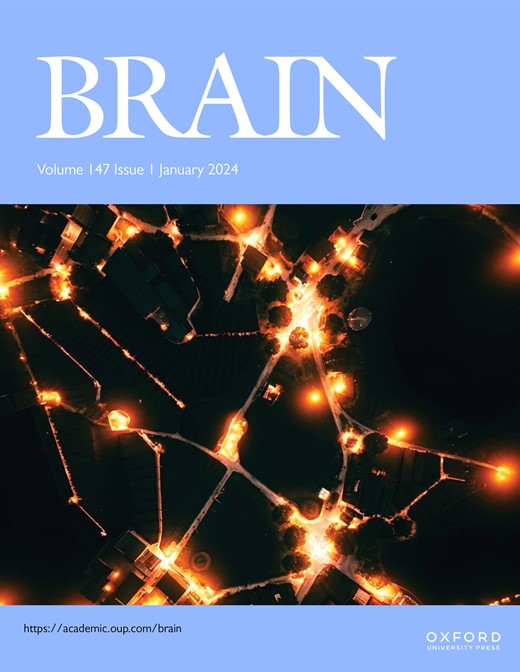Dysregulated cortical excitability and tau phosphorylation in a β3 integrin mouse model of autism
IF 10.6
1区 医学
Q1 CLINICAL NEUROLOGY
引用次数: 0
Abstract
Autism spectrum disorder is a complex neurodevelopmental disease characterized by altered cortical network excitability. Recent genetic studies have identified deep layer V cortical pyramidal neurons in the frontal cortex as central to autism pathophysiology, yet the cortical circuits, plasticity mechanisms and molecular signalling pathways involved remain poorly understood. Layer V pyramidal neurons consist of two main types with distinct functional roles: intratelencephalic neurons, which respond to low-frequency stimulation and project within the cortex and striatum, and pyramidal tract neurons, which are tuned to theta-frequency inputs and convey information to subcortical structures. Determining which of these two neuron types is more critical to autism pathophysiology and whether disruptions in their synaptic connectivity or intrinsic excitability contribute to autism-related dysfunctions would significantly advance our understanding of the disorder. Integrins, a family of cell adhesion molecules, are vital for neuronal function. The gene encoding β3 integrin (ITGB3) is genetically linked to autism spectrum disorder, with rare mutations identified in affected individuals, while Itgb3 knockout mice exhibit autism-like behaviours, including impaired social memory and increased grooming. However, it remains unclear why loss of β3 integrin is associated with autism spectrum disorder, how it disrupts cortical circuits, and which plasticity mechanisms and molecular pathways are involved. Here, we demonstrate that β3 integrin selectively regulates the excitability of pyramidal tract neurons in the medial prefrontal cortex. Using electrophysiology, proteomics and molecular approaches, we show that β3 integrin regulates the gain, adaptation and precision of action potential discharge by controlling the surface expression of Ca2+-activated SK2 channels. Genetic ablation of Itgb3 impaired intrinsic excitability and SK2 channel function in pyramidal tract neurons, with no effects in intratelencephalic neurons. Furthermore, we identified Tau, a protein traditionally linked to neurodegenerative diseases, as part of the SK2 channel interactome. Proteomic analyses revealed altered protein kinase A-dependent phosphorylation of Tau in Itgb3 knockout mice, while protein kinase A inhibition restored SK2 channel currents, thereby connecting phosphorylation changes to excitability deficits. Our findings expand the current mechanistic framework linking signalling pathway dysfunctions to cortical excitability deficits, highlighting the dysregulation of pyramidal tract neuron excitability as a core feature of autism pathophysiology and demonstrating the involvement of β3 integrin, SK2 channels, Tau and PKA in this process. Because pyramidal tract neurons serve as final integrators of cortical computations before relaying information outside the cortex, their impaired excitability may disrupt communication with subcortical targets, contributing to the complex pathophysiology of autism spectrum disorder.自闭症小鼠β3整合素模型中皮质兴奋性失调和tau磷酸化
自闭症谱系障碍是一种以皮层网络兴奋性改变为特征的复杂神经发育疾病。最近的遗传学研究已经确定额叶皮层的深V层皮质锥体神经元是自闭症病理生理的核心,但涉及的皮质回路、可塑性机制和分子信号通路仍然知之甚少。第V层锥体神经元主要由两类具有不同功能的神经元组成:一类是脑外神经元,它们响应低频刺激并投射到皮层和纹状体内;另一类是锥体束神经元,它们被调谐到低频输入并向皮层下结构传递信息。确定这两种神经元类型中的哪一种对自闭症病理生理更重要,以及它们的突触连接中断或内在兴奋性是否会导致自闭症相关功能障碍,将大大提高我们对自闭症的理解。整合素是一类细胞粘附分子,对神经元功能至关重要。编码β3整合素(ITGB3)的基因与自闭症谱系障碍有关,在受影响的个体中发现了罕见的突变,而ITGB3敲除小鼠表现出自闭症样行为,包括社交记忆受损和打扮增加。然而,目前尚不清楚为什么β3整合素的缺失与自闭症谱系障碍有关,它是如何破坏皮层回路的,以及其中涉及的可塑性机制和分子途径。在这里,我们证明β3整合素选择性地调节内侧前额皮质锥体束神经元的兴奋性。利用电生理学、蛋白质组学和分子方法,我们发现β3整合素通过控制Ca2+激活的SK2通道的表面表达来调节动作电位放电的增益、适应性和精度。基因消融Itgb3损伤锥体束神经元的固有兴奋性和SK2通道功能,对脑内神经元无影响。此外,我们确定了Tau蛋白,一种传统上与神经退行性疾病相关的蛋白,作为SK2通道相互作用组的一部分。蛋白质组学分析显示,Itgb3敲除小鼠中Tau蛋白激酶A依赖性磷酸化发生改变,而蛋白激酶A抑制恢复SK2通道电流,从而将磷酸化变化与兴奋性缺陷联系起来。我们的研究结果扩展了信号通路功能障碍与皮层兴奋性缺陷之间的机制框架,强调了锥体束神经元兴奋性失调是自闭症病理生理的核心特征,并证明了β3整合素、SK2通道、Tau和PKA参与了这一过程。由于锥体束神经元在将信息传递到皮层外之前是皮层计算的最终整合者,因此它们的兴奋性受损可能会破坏与皮层下目标的交流,从而导致自闭症谱系障碍的复杂病理生理。
本文章由计算机程序翻译,如有差异,请以英文原文为准。
求助全文
约1分钟内获得全文
求助全文
来源期刊

Brain
医学-临床神经学
CiteScore
20.30
自引率
4.10%
发文量
458
审稿时长
3-6 weeks
期刊介绍:
Brain, a journal focused on clinical neurology and translational neuroscience, has been publishing landmark papers since 1878. The journal aims to expand its scope by including studies that shed light on disease mechanisms and conducting innovative clinical trials for brain disorders. With a wide range of topics covered, the Editorial Board represents the international readership and diverse coverage of the journal. Accepted articles are promptly posted online, typically within a few weeks of acceptance. As of 2022, Brain holds an impressive impact factor of 14.5, according to the Journal Citation Reports.
 求助内容:
求助内容: 应助结果提醒方式:
应助结果提醒方式:


